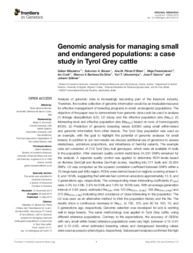Genomic analysis for managing small and endangered populations: a case study in Tyrol Grey cattle.
Genomic analysis for managing small and endangered populations: a case study in Tyrol Grey cattle.
Author(s): MÉSZÁROS, G.; BOISON, S. A.; O'BRIEN, A. M. P.; FERENCAKOVIC, M.; CURIK, I.; SILVA, M. V. G. B.; UTSONOMIYA, Y. T.; GARCIA, J. F.; SÖLKNER, J.
Summary: Analysis of genomic data is increasingly becoming part of the livestock industry. Therefore, the routine collection of genomic information would be an invaluable resource for effective management of breeding programs in small, endangered populations. The objective of the paper was to demonstrate how genomic data could be used to analyse (1) linkage disequlibrium (LD), LD decay and the effective population size (NeLD); (2) Inbreeding level and effective population size (NeROH) based on runs of homozygosity (ROH); (3) Prediction of genomic breeding values (GEBV) using small within-breed and genomic information from other breeds. The Tyrol Grey population was used as an example, with the goal to highlight the potential of genomic analyses for small breeds. In addition to our own results we discuss additional use of genomics to assess relatedness, admixture proportions, and inheritance of harmful variants. The example data set consisted of 218 Tyrol Grey bull genotypes, which were all available AI bulls in the population. After standard quality control restrictions 34,581 SNPs remained for the analysis. A separate quality control was applied to determine ROH levels based on Illumina GenCall and Illumina GenTrain scores, resulting into 211 bulls and 33,604 SNPs. LD was computed as the squared correlation coefficient between SNPs within a 10 mega base pair (Mb) region. ROHs were derived based on regions covering at least 4, 8, and 16 Mb, suggesting that animals had common ancestors approximately 12, 6, and 3 generations ago, respectively. The corresponding mean inbreeding coefficients (F ROH) were 4.0% for 4 Mb, 2.9% for 8 Mb and 1.6% for 16 Mb runs. With an average generation interval of 5.66 years, estimated NeROH was 125 (NeROH>16 Mb), 186 (NeROH>8 Mb) and 370 (NeROH>4 Mb) indicating strict avoidance of close inbreeding in the population. The LD was used as an alternative method to infer the population history and the Ne. The results show a continuous decrease in NeLD, to 780, 120, and 80 for 100, 10, and 5 generations ago, respectively. Genomic selection was developed for and is working well in large breeds. The same methodology was applied in Tyrol Grey cattle, using different reference populations. Contrary to the expectations, the accuracy of GEBVs with very small within breed reference populations were very high, between 0.13-0.91 and 0.12-0.63, when estimated breeding values and deregressed breeding values were used as pseudo-phenotypes, respectively. Subsequent analyses confirmed the high accuracies being a consequence of low reliabilities of pseudo-phenotypes in the validation set, thus being heavily influenced by parent averages. Multi-breed and across breed reference sets gave inconsistent and lower accuracies. Genomic information may have a crucial role in management of small breeds, even if its primary usage differs from that of large breeds. It allows to assess relatedness between individuals, trends in inbreeding and to take decisions accordingly. These decisions would be based on the real genome architecture, rather than conventional pedigree information, which can be missing or incomplete. We strongly suggest the routine genotyping of all individuals that belong to a small breed in order to facilitate the effective management of endangered livestock populations.
Publication year: 2015
Types of publication: Journal article
Unit: Embrapa Dairy Cattle
Observation
Some of Embrapa's publications are published as ePub files. To read them, use or download one of the following free software options to your computer or mobile device. Android: Google Play Books; IOS: iBooks; Windows and Linux: Calibre.
Access other publications
Access the Agricultural Research Database (BDPA) to consult Embrapa's full library collection and records.
Visit Embrapa Bookstore to purchase books and other publications sold by Embrapa.

